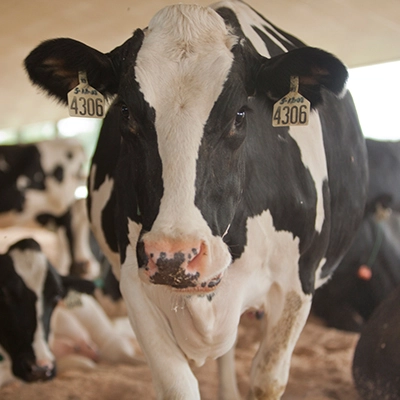Antibiotics: A Last-Resort Necessity of Cow Care
Farmer and veterinarian Karen Jordan can recite with ease the birthdate of a particular cow on her dairy farm: Dec. 19, 2006.
She knows the tendencies of this cow – along with the rest of her herd – so well that she can detect when something isn’t quite right.
Recently, Jordan saw this cow walk by and noticed that its udder was not as filled with milk as it should have been. A closer look at the cow’s eyes signaled dehydration, and Jordan could see its stomach was not rounded with feed, indicating it wasn’t eating. Jordan checked the cow’s temperature and got a reading of 105 degrees, well above the optimal 101.5.
Jordan had seen enough. She led the cow to the farm’s version of a hospital – a pen where she could quietly rest alone on grass and receive medical treatment.
But there would be no waiting for a veterinarian to arrive. Jordan, who runs the Siler City, N.C., dairy with her husband Norman, doubles as a veterinarian. She oversees the medical needs of their herd, as well as several others in the area.
Jordan said veterinarians typically educate farmers and their employees on ways to identify cows that may need medical attention.
“You have to know what normal is,” Jordan said. “You have to understand normal cow behavior, the normal shape of a cow so you can tell if she isn’t eating. Is she walking a straight line? Does she have diarrhea? Farmers know that if a cow feels bad she’s going to head to a corner of the barn looking for solitude. We do a lot of things during the harvesting of milk each day that allows us to check the health status of a cow.”
In this case, the diagnosis was mastitis, a bacterial infection of the cow’s udder. Jordan gave the cow an IV to quell the dehydration, followed by an anti-inflammatory drug. She then administered an antibiotic to fight the mastitis, which can cause death if left untreated.
Jordan documented every detail of her treatment plan in a journal and gave directions to employees who made sure the cow had adequate feed and water. She also checked on her patient’s vitals every three hours or so.
As expected, the cow fully recovered and rejoined its healthy herd mates, but not before the antibiotic’s withholding time had passed. Jordan, along with other farmers, strictly follows the protocols for drug use and won’t return a cow to the milking herd until the drug has cleared the cow’s system.
Additionally, samples are taken of every tanker load of milk that leaves dairy farms and the milk is tested at the processing plant for antibiotic residue to assure a safe product for consumers.
Jordan sees antibiotics as a necessary tool to treat illnesses and prevent premature death, but said she and other farmers focus on measures that minimize the risk of a cow becoming ill in the first place.
“Everything we do every day on the farm focuses on cow comfort, cow performance, appropriate nutrition … using antibiotics is way, way, way down on the list,” she said. “It’s a tool we’ll use when something else has broken in the system.
“But it’s the work we do every day so we don’t have to use antibiotics that’s the real story.”















